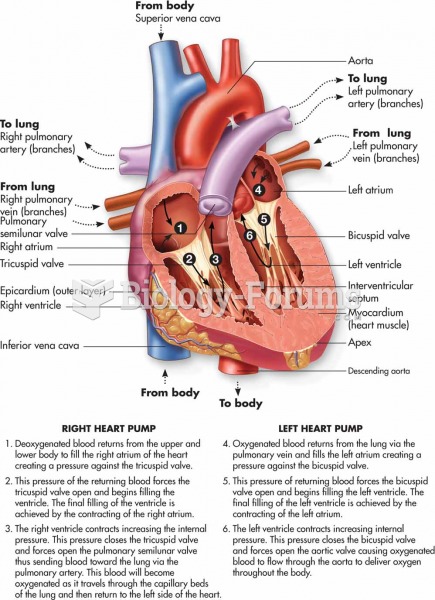Answer to Question 1
Answer: 2, 1, 3, 6, 5, 4, 7
1. The second step is to look at the PaCO2. If the PaCO2 is less than 35, then more carbon dioxide is being exhaled. If the PaCO2 is greater than 45, then more carbon dioxide is being retained.
2. The pH is the first step and is analyzed to determine if acidosis or alkalosis is present. A pH of less than 7.35 is acidosis. A pH greater than 7.45 is alkalosis.
3. The third step is to evaluate the relationship between the pH and the PaCO2. This relationship could indicate a respiratory problem. If the pH is acidotic and the carbon dioxide level is greater than 45, then the client could be experiencing respiratory acidosis. If the pH is alkalotic and the carbon dioxide level is below 35, then the client could be experiencing respiratory alkalosis.
4. The sixth step is to look for compensation. Two things can occur in renal compensation. In respiratory acidosis, the kidneys retain HCO3 to buffer the excess acid, so the HCO3 is > 28 mEq/L. In respiratory alkalosis, the kidneys excrete HCO3 to minimize the alkalosis, so the HCO3 is < 24 mEq/L. Two things can also occur in respiratory compensation. In metabolic acidosis the rate and depth of respirations increase, increasing carbon dioxide elimination, so the PaCO2 is < 35 mmHg. In metabolic alkalosis respirations slow and carbon dioxide is retained, so the PaCO2 is > 45 mmHg.
5. The fifth step is to evaluate the pH, HCO3, and base excess for a possible metabolic problem.If the pH is < 7.35, the HCO3 is < 24 mEq/L, and the BE is < 2 mEq/L, then low bicarbonate levels and high H + concentrations are causing metabolic acidosis. If the pH is > 7.45, the HCO3 is > 28 mEq/L, and the BE is > +2 mEq/L, then high bicarbonate levels are causing metabolic alkalosis.
6. The fourth step is to look at the bicarbonate level. If the bicarbonate level is less than 24, then the levels are lower than normal. If the bicarbonate level is greater than 28, then the bicarbonate levels are higher than normal.
7. The final step is to evaluate oxygenation. If the PaO2 is less than 75 mmHg, then the client is experiencing hypoxemia and possible hypoventilation. If the PaO2 is greater than 100 mmHg, then the client is hyperventilating.
Answer to Question 2
Answer: C
The client receiving sodium bicarbonate is prone to alkalosis; monitor for cyanosis, slow respirations, and irregular pulse. The client's symptoms do not indicate alkalosis so infusion should not be stopped. The client continues to exhibit signs of acidosis; symptoms of acidosis include lethargy, confusion, CNS depression leading to coma, and a deep, rapid respiration rate that indicates an attempt by the lungs to rid the body of excess acid, and the physician should be notified. The infusion should not be increased or decreased without a practitioner order.







